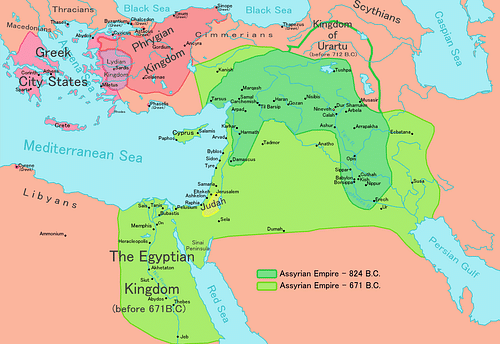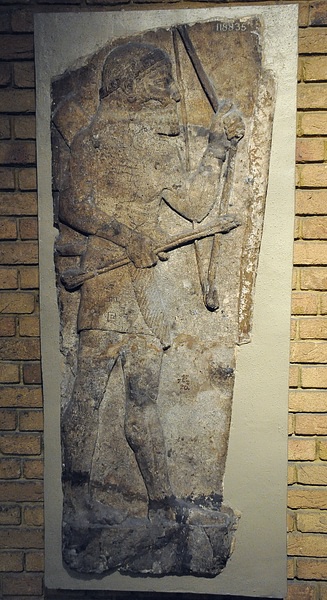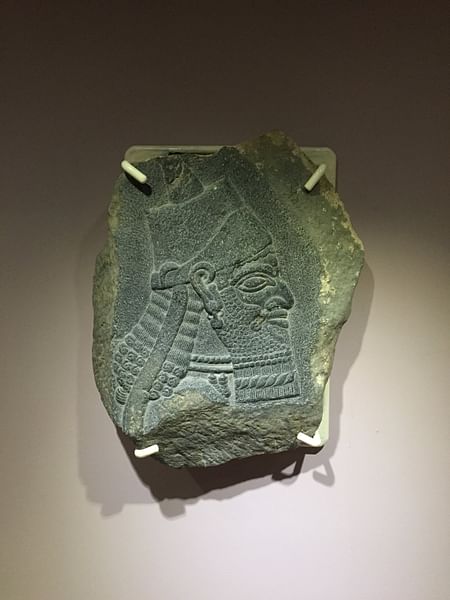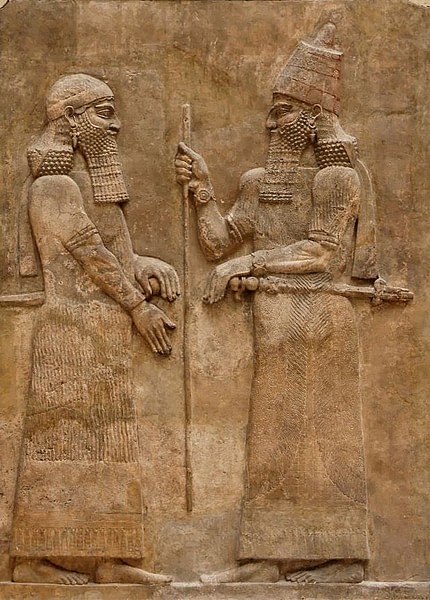
Sargon II (r. 722-705 BCE) was one of the most important kings of the Neo-Assyrian Empire as founder of the Sargonid Dynasty which would rule the empire for the next century until its fall. He was a great military leader, tactician, patron of the arts and culture, and a prolific builder of monuments, temples, and even a city.
His greatest building project was the city of Dur-Sharrukin (`Fortress of Sargon', modern day Khorsabad, Iraq) which became the capital of the Assyrian Empire under his reign. He was the son of Tiglath Pileser III (r. 745-727 BCE) and possibly the younger brother of Shalmaneser V (r. 727-722 BCE). He was not the chosen heir but took the throne from his brother under circumstances which remain unclear.
It is likely, however, that he orchestrated a coup after he had grown tired of what he saw as his brother's inept reign. Like the great Sargon of Akkad (r. 2334-2279 BCE), founder of the Akkadian Empire, whom he modeled himself after, his throne name of Sargon means `true king' which scholars have interpreted as his means of legitimizing himself following the coup.
His birth name is unknown as is whatever position he held at court prior to assuming the throne. Although regions of the empire revolted when he took control, and he does not seem to have had the support of the court, Sargon II maintained the policies and strategies initiated by his father, improved the military and economy, and brought the Assyrian Empire to its greatest height politically and militarily. His reign is considered the peak of the Neo-Assyrian Empire. He was succeeded by his son Sennacherib (r. 705-681 BCE).
Early Reign & Conquests
Sargon II was middle-aged when he came to the throne. What role he played in his father's administration is unknown as no inscriptions identify Tiglath Pileser III's younger son by name. The only reason scholars know Sargon II was Tiglath Pileser III's son is from Sargon II's own inscriptions and court documents from his reign. Sargon II also refers to Shalmaneser V as his brother by blood and not `brother' as an honorary title.
Shalmaneser V tried hard to hold his father's empire together and expand on it, which he succeeded in to a degree, but his military exploits were not carried out with the speed and efficiency that had marked his father's reign and his taxation and labor policies were unpopular with the people. The Assyrian records are silent on how he died. Scholar Susan Wise Bauer comments on this, writing:
At this point [in history] the Assyrian accounts blink. When they reopen, Shalmaneser V – only five years on the throne and carrying on two sieges simultaneously – is dead. A new king has taken the throne under the royal name Sargon II. If Shalmaneser had died in battle [the records] would likely have said so. Most likely his successor Sargon II was a younger son of Tiglath Pileser, taking advantage of his brother's weakness to seize power; those long and apparently fruitless sieges cannot have been popular with the army and Shalmaneser V had also made himself unpopular back home by trying to introduce an obligation of forced labor to the people of Assur. This had not gone over well. (374)
Sargon II took the throne, abolished the taxation and labor policies, and ended the sieges his brother's administration had prolonged. He conquered Samaria and destroyed the kingdom of Israel. Sargon's inscriptions record that he deported 27,290 Israelites from their homeland and re-settled them to regions throughout the empire from Anatolia across to the Zagros Mountains (the extent of the Assyrian Empire under his reign, cited in Pritchard, p. 195).
In doing so, he was simply following Assyrian political and military procedure which had been initiated by the king Adad-Nirari I (r. 1307-1275 BCE) and practiced ever since. This particular incident involving the Assyrian re-settlement policy resulted in the famous loss of the Ten Tribes of Israel. Bauer notes that, however well cared for the deportees may or may not have been treated:
Deportation was a kind of genocide, murder not of persons, but of a nation's sense of itself. These Israelites became known as the `lost ten tribes' not because the people themselves were lost, but because their identity as descendants of Abraham and worshippers of Yahweh was dissipated into the new wild areas where they were now forced to make their homes. (375)
With Israel conquered and his brother's military campaigns brought to a conclusion, Sargon II turned his attention to the regions of the empire which had revolted against him.
Military Campaigns
In 720 BCE he marched on the city of Hamat (in the region of Syria) and destroyed it. He then continued on to crush the other cities which had joined the rebellion, Damascus and Arpad, at the Battle of Qarqar. With order restored in the Syrian regions, he marched back to his capital at Kalhu and ordered the deportation and resettlement of those Assyrian communities in the region which had failed to support his ascent to the throne or had actively rebelled against him. Over 6,000 “ungrateful citizens” were deported to Syria to rebuild Hamat and the other settlements and cities destroyed in Sargon II's campaign.
At this time, word reached the court that a tribal chief named Merodach-Baladan had seized control in the city of Babylon. Sargon II left Kalhu at the head of his army and met the combined forces of Babylon and Elam in battle on the plains outside of the city of Dur. Sargon II's army was repelled by the Elamites (the Babylonians arrived too late to have any effect) and left the field; and so he lost the city of Babylon and the regions of the south.
Sargon II again returned to Kalhu and set his administration in order. In c. 717 BCE he first conceived of the idea of his own capital city built on virgin land and commissioned that it be built. This city would become Dur-Sharrukin, a central preoccupation of the king throughout his reign. He personally designed the city and chose the location but then again was drawn away by military matters. He appointed his son, the crown prince Sennacherib, as his administrator and then set out on campaign.
The city of Carchemish was the capital of a very wealthy kingdom which had long enjoyed prosperity due to its location on a trade route. In 717 BCE, Sargon II accused the king of Carchemish of intrigue with the enemies of Assyria and invaded the city with his entire army. There was no army to speak of which Carchemish could field and so the city was easily taken. Sargon II sent captives and the massive treasury of the city back to Kalhu.
So rich was this treasury in silver that it “changed the Assyrian economy from a bronze-based to a silver-based financial economy which relied on silver according to the standard of Carchemish” (Radner, 1). In 716 BCE he conquered the Mannaeans (a people of present-day Iran) and looted their temples and, in 715 BCE, he marched through Media conquering those cities and settlements and sending wealth and captives back to Kalhu.
All during this time, however, a persistent problem had been presenting itself in the north. The Kingdom of Urartu had been conquered by his father but never completely so. During the reign of Shalmaneser V, Urartu had risen again and was making incursions into Assyria from bases along the border. In 719 and 717 BCE Sargon II had to send troops at his borders against the Urartians who had invaded and instigated conflict among the settlements. In 715 BCE Urartu mounted a full-scale invasion and took 22 Assyrian cities along the border. Sargon II retaliated by re-taking the cities, driving the Urartian forces out of Assyrian lands, and razing their southern provinces along the border.
He understood, however, that these kinds of invasions would continue and he would have to repeatedly expend time and resources in dealing with them. In order to secure his empire against future incursions, Sargon II had to decisively defeat Urartu. The difficulty lay in their strategically located kingdom which was nestled in the foothills of the Taurus Mountains and heavily defended. It was for this reason that the previous Assyrian kings who had fought against Urartu had never fully defeated them. The Urartian forces were always able to slip away into the mountains after an engagement, re-group, and then return to harass the empire.
The Urartu Campaign of 714 BCE
The Kingdom of Urartu (also known as the biblical Kingdom of Ararat and Kingdom of Van) had grown in power throughout the 13th to the 11th century BCE. The Temple of Haldi, in the holy city of Mushashir in Urartu, had been an important pilgrimage center since the 3rd millennium BCE and the offerings from kings, princes, nobility, and merchants filled its treasury. The Urartians had grown in wealth from trade and from caravans of pilgrims coming to visit Mushashir. To ensure continued prosperity, the Urartians tried to keep the lowlands around their kingdom under their control. From their fortress in the mountains they continually raided and annexed territories in the lowlands.
The Urartians were fierce warriors who bred some of the best horses in the region and raised them specifically for combat. Shalmaneser I (r. 1274-1245 BCE) first mentioned Urartu in Assyrian inscriptions in relating his conquest of the kingdom but, since his time, the Urartians showed themselves resilient and resourceful in that, each time they were beaten, they rose again. Sargon II writes of them respectfully, even though they were his enemies, as noted by Bauer:
Sargon's own accounts speak admiringly of the Urartian king Rusas and the network of canals and wells which he built; of the herds of well-bred and guarded horses, raised in protected valleys until they were needed for war; of the splendid efficiency of Urartian communication, with watchtowers built high on mountain peaks, guarding heaps of fuel that could be lit at a moment's notice. One beacon, lit, flared up on its mountaintop into an enormous bonfire that appeared as a spark to the next distant post, where the next bonfire could then be lit. They shone like `stars on mountaintops,' in Sargon's own words, and spread news of invasion faster than a messenger could ride. (376)
In these same inscriptions, Sargon II notes the existence of the qanat system of irrigation which would become instrumental in the later Achaemenid Empire under Cyrus II (the Great, r. c. 550-530 BCE). Although the qanat system - a brilliant innovation bringing deep ground water to the surface - is often attributed to Cyrus the Great, it was actually an earlier Persian invention.
Sargon II understood that the only way to defeat the Urartians would be to surprise them. He therefore launched his invasion of Urartu in 714 BCE to carefully avoid an obvious frontal attack. Leading the army himself, he marched east, skirting the Urartu stronghold, and hoping to bring his forces, unnoticed, up through the flat lands to surprise Urartu from the rear.
The Assyrians were a lowland people with no experience in mountain warfare. The previous Assyrian kings who had fought Urartu drove them from the lowlands but never ascended the slopes into the mountains. Sargon II's forces encountered:
Looming and unfamiliar slopes covered with thick forests where unknown enemies waited…The cedar forests on the mountain slopes, like those into which Gilgamesh had ventured so many years ago, sheltered an enemy which was more terrifying because it was unseen. (Bauer, 376)
Sargon II, therefore, set the vanguard of his army to clearing a path for his forces to proceed. Sargon II describes this himself in a letter he wrote to the god Ashur in which he also makes clear the great challenges he faced in his campaign:
Mount Simirria, a great mountain peak that points upwards like the blade of a lance, and raises its head over the mountain where the goddess Belet-ili lives, whose two peaks lean against heaven on high, whose foundations reach into the midst of the netherworld below, which, like the back of a fish, has no road from one side to the other and whose ascent is difficult from front or back, ravines and chasms are deeply cut in its side, and seen from afar, it is shrouded in fear, it is not good to climb in a chariot or with galloping horses, and it is very hard to make infantry progress in it; yet, with the intelligence and wisdom that the gods Ea and Belet-ili destined for me and who broadened my stride to level the enemy land, I made my engineers carry heavy bronze axes, and they smashed the peaks of the high mountain as if it were limestone and made the road smooth. I took the head of my army and made the chariots, cavalry, and battle troops that accompany me fly over it like eagles. I made the support troops and foot solders follow them, and the camels and pack mules jumped over the peaks like goats raised in the mountains. I made the surging flood of Assyrians easily cross over its difficult height and on top of that mountain I set up camp. (Van De Mieroop, 216)
The army had, by this time, been marching through hard terrain in early summer and, though they had been resupplied and watered by previously conquered Medes, they were exhausted by the time they made final camp. Sargon writes how, “their morale turned mutinous. I could give no ease to their weariness, no water to quench their thirst.” He selected a battlefield and deployed his troops just as King Rusas arrived with his forces for battle; but Sargon's army would not fight. They had traveled too far and endured too much on the march and now, with the objective before them, they refused to engage the enemy.
Sargon II had come too far and expended too many resources to simply retreat or surrender. He called his personal bodyguard around him and then, as Bauer writes:
He led them in a frantic and suicidal attack on the nearest wing of Rusas's force. The wing gave ground in the face of his desperate savagery; and according to his own account, Sargon's army, seeing him fling himself into the line, took courage and followed him in. The Urartian army wavered, broke, and began to retreat. The retreat turned into a rout. The Assyrian army chased the disintegrating enemy westwards, past Lake Urmia and into their own territory. Rusas abandoned any attempt to hold his own capital city, Turushpa, and fled into the mountains. (377)
With Urartu defeated, and fearing that his troops would mutiny if he led them further into the mountains in pursuit, Sargon II turned his forces around and headed back towards Assyria. He paused at the city of Mushashir, however, sacked it, and plundered the holy temple of Haldi carrying off literally tons of gold, silver, and precious gems.
Sargon writes that, when King Rusas heard of the sack of Mushashir, “The splendor of Assur overwhelmed him and with his own iron dagger he stabbed himself through the heart, like a pig, and ended his own life.” The Urartians were defeated, and in less than six months of campaign, and so Sargon II returned to Kalhu at the head of his army in glory, carrying with him the immense wealth of Mushashir.
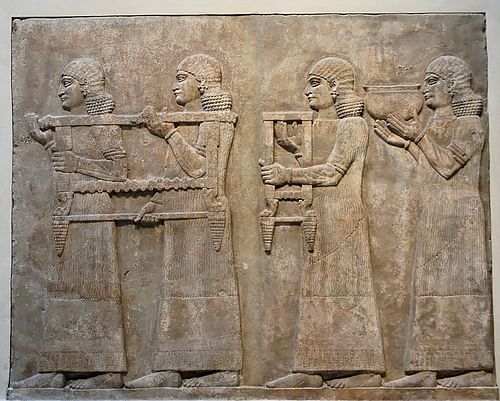
Dur-Sharrukin & Babylon
To celebrate his victory, and create a lasting monument to his campaign, he turned his attention to the construction and adornment of his city Dur-Sharrukin in the year 713 BCE. The city would be decorated with reliefs depicting Sargon II's conquests and, especially, the sack of Mushashir. He took personal interest in every aspect of the city's construction. His official letters, which were found in the archives of Kalhu and Nineveh, make the level of his involvement in the project clear. In one letter he writes:
The king's word to the governor of Kalhu: 700 bales of straw and 700 bundles of reed, each bundle more than a donkey can carry, must arrive in Dur-Sharrukin by the first of the month Kislev. Should one day pass by, you will die.
For three years, Sargon II supervised the building of Dur-Sharrukin while also entertaining envoys from Egypt, Nubia, and other nations at his palace in Kalhu. He controlled the whole north of Mesopotamia, Anatolia, and had subdued the Kingdom of Urartu; but he had not yet taken Babylon and the lands of the south back from Merodach-Baladan. The last time he had marched on Babylon and her Elamite allies, he had taken a straight-forward approach and been defeated; this time he decided on another tactic.
In 710 BCE, Sargon II left the building of Dur-Sharrukin and the administration of the empire in the hands of Sennacherib and marched at the head of his army east into Elam. He lay waste the villages and cities and then turned in a half-circle to come at Babylon from the southeast. Merodach-Baladan fled the city with as many riches as he could carry including his royal furniture: a silver bed, throne, table, the royal ablution-pitcher, and his own necklace (Bauer, 379). He sent these as gifts to the king of Elam asking for sanctuary.
Sargon II's inscription regarding what followed reads: "The Elamite scoundrel accepted his bribe but feared my military power; so he blocked Merodach-Baladan's way and forbade him to go into Elam.” Merodach-Baladan fled to his native city of Bit-Yakin on the Persian Gulf where Sargon II's forces followed him, attacked, and destroyed the city. Sargon II reports, “I burned it with fire and even its foundations were torn up."
He allowed Merodach-Baladan to live, however, and this decision has mystified historians and scholars ever since. This same Chaldean chief would later emerge to cause trouble for Sargon II's successor, Sennacherib, who dealt with the day-to-day governance of the empire while his father was away on military campaigns.
Final Years & Legacy
Having conquered the south, Sargon II marched to Babylon and claimed kingship. He now ruled all of Mesopotamia and the Assyrian Empire was at its greatest expanse, wealth, and might to date. He chose to reside at Babylon and entertained the envoys of other kings and nations, including those of the king Mita of Phrygia who is identified by some scholars as King Midas, famed for his golden touch.
For three years Sargon II remained in Babylon, regularly receiving updates from Sennacherib back in Kalhu on the progress of Dur-Sharrukin and then, in 707 BCE, he received word his city was completed. He left Babylon and moved into his palace at Dur-Sharrukin in 706 BCE. He made his new city the Assyrian capital and engaged in building projects, commissioning art work, and writing of his conquests. Bauer notes:
The reliefs in his new palace at [Dur-Sharrukin] show his greatness; his huge figure pushes even the forms of the gods into the background. He was the second Sargon, the second founder of the empire, the king of a second Assyria with new borders, a new capital city, and a newly fearsome power. (381)
He finally had the city which he had wanted built in his honor; but he would not enjoy it for long.
The people of Tabal, a province in central Anatolia, had broken away from the empire and Sargon II needed to bring the region back under control. Instead of sending someone else to handle the campaign, Sargon II again left Sennacherib in charge of the government and led his army across Mesopotamia and into Anatolia in 705 BCE.
Tabal put up a strong resistance to the Assyrian forces and Sargon II was killed in battle. The fighting was so fierce that his body could not be retrieved and was lost to the enemy. The Assyrians were driven from the field and returned home without their leader.
The death of the king and loss of his body were considered an enormous tragedy and an evil omen. Somehow, it was thought, Sargon II had committed some sin in order for the gods to have abandoned him so completely on the battlefield. Dur-Sharrukin was abandoned immediately and the capital moved to Nineveh by Sennacherib. The new king, who had been repeatedly left at home while Sargon II embarked on glorious campaigns, clearly resented his father as he wrote nothing and built nothing to honor his memory. None of Sennacherib's inscriptions mention his father at all and no building or monument was raised in his name.
Sargon's skill as a military leader and politician enlarged the Assyrian Empire and brought it to its peak as the greatest empire of the Near East and yet his death in battle, and his son's refusal to acknowledge him after his death, marred his accomplishments for those who came immediately after him. Dur-Sharrukin with its great reliefs and paintings stood empty as everything which could be moved was brought to Nineveh. It is from Sargon's own inscriptions and the writings of later chroniclers that the exploits and achievements of King Sargon II are known today and it is from these that his legacy as a great king have come to be recognized. Directly after his death, however, the people seem to have been encouraged to forget that such a king had ever reigned.
